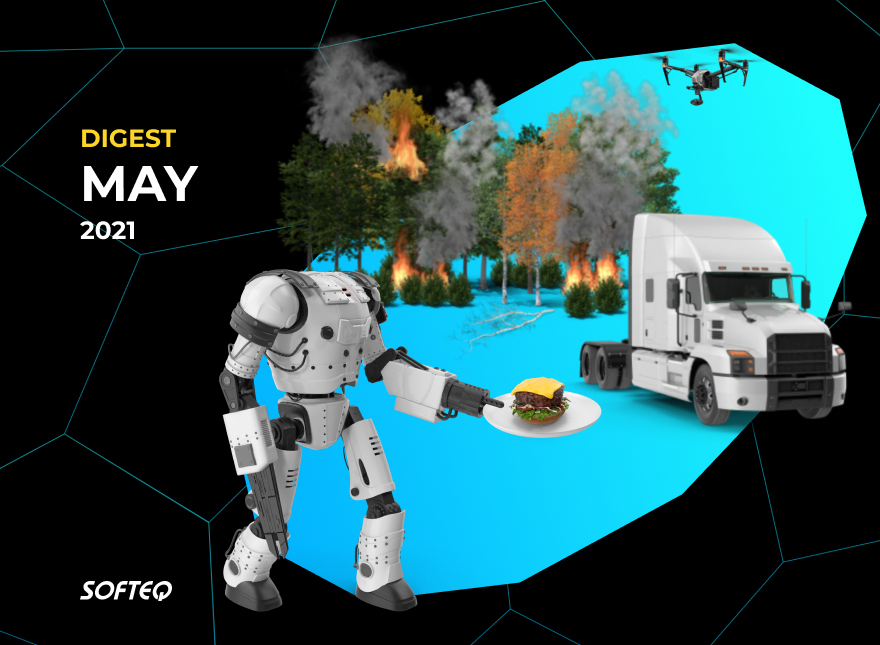This is What Techies Talked About in May

In this issue of the Tech Digest: self-driving cars leverage sensors to drive safer than humans, drones help prevent wildfires, and AI-assistance simplifies kitchen and inventory tasks. All that and more in a 10-minute read.
Autonomous Vehicles Drive Safer Than Humans Do
Whether or not self-driving vehicles can develop the kind of dynamic, adaptive, common-sense reasoning that humans have, autonomous vehicles (AVs) have already demonstrated their ability to leverage sensor systems to drive more safely.
A few weeks ago, the CTO of Cruise tweeted an example of one of their AVs demonstrating a safety behavior: it moves over to make room for a cyclist. A human might not necessarily do this for a cyclist, but for an autonomous car, it's the obvious safety choice. So how can AVs effectively leverage their superior hardware into superior safety.
Drones and IoT Help Detect Wildfires Earlier On
The speed at which a wildfire can rip through an area and wreak havoc is terrifying. Early detection of these events is critical for fire management efforts, whether that involves calling in firefighters or evacuating nearby communities. Currently, early fire detection in remote areas is typically done by satellite—but this approach can be hindered by cloud cover. What’s more, even the most advanced satellite systems only detect fires once the burning area reaches an average size of 7 square miles (about 18 km2).
To detect wildfires earlier on, one company proposed a novel solution that harnesses IoT sensors and a fleet of drones. And the solution has proven to be feasible: sensors are scattered throughout regions of concern, and if a fire ignites, patrolling drones receive signals from them and notify the nearby firefighting department. Learn more about this promising UAV-IoT system.
Smart Robots Help Cooks Deliver Precision-Level Cooking
What about a smart kitchen assistant? For example, when cooks are preparing a meal, an advanced robot that incorporates machine learning, sensors, and computer vision might help them track a food item on a grill and monitor cooking time automatically. One company now makes it come true: they invented a new standalone AI for fast food restaurants. Here's why it's a smart play.
Miso Robotics delivers a SaaS offering named CookRight. It is the world's first AI-powered cooking platform meant to simplify kitchen and inventory tasks, improve food quality, drive efficiency, and save money by closely monitoring supply chain issues. For example, it incorporates automated cooking time control to serve perfectly-grilled burgers. Follow the link to learn more about this smart kitchen solution.
Cloud Telematics Platforms Help Small Logistics Businesses Succeed
Can small logistics companies compete with larger firms with IT budgets to support full-scale logistics, IoT, and analytics? One Canadian company proves it is possible. Richelieu Hardware operates only a two-truck fleet consisting of one five-ton truck and one 18-wheeler, but was able to optimize its efficiency and improve profitability on a daily basis.
By subscribing to Geotab, a SaaS fleet management cloud telematics platform, the company saw significant improvements in delivery performance, fuel consumption, maintenance costs, and customer satisfaction. What else can this subscription-based solution bring to small businesses?
Every Announcement from Google's Developers Conference
In 2020, Google canceled its annual I/O developer conference due to the COVID-19 pandemic. Even an all-virtual event didn’t take place. Now, in 2021, Google delivered the all-virtual I/O we were hoping for last year. The search giant revealed new upgrades such as Android 12, tweaks to Wear OS, and a variety of other new software novelties. Let’s take a look at all the exciting stuff that has come out of the event.
